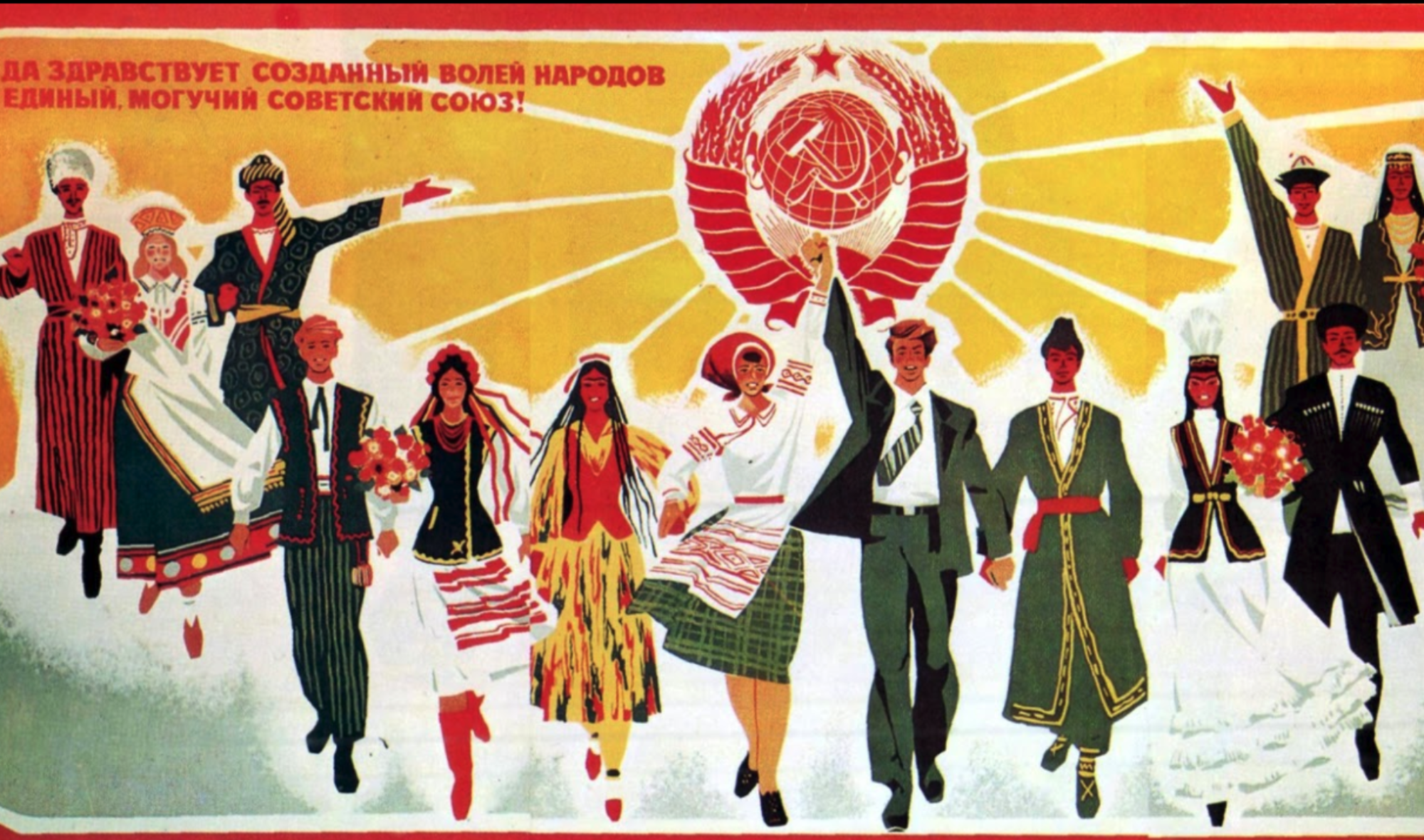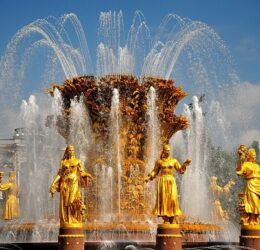Perhaps one of the most iconic things to emerge from the Soviet Union is the propaganda posters. The revolution, and subsequent propaganda thereafter, are what birthed the new brand of politically charged posters that we see today. It can be seen in something as frequent as a presidential ad campaign, to a NASA poster sold in a Smithsonian museum. These posters could be found throughout the Soviet Union, focusing on things such as creating the third communist international, World War Two, and things as exciting as Soviet space travel.

“Ten Commandments of the Proletariat” circa 1920 exemplifies a unique form of propaganda advocating for communism during the civil war fought mainly between the Red (Bolsheviks) Army and the White (Russian Republic) Army (Lavin, 2014). It addresses the reader as “Comrade Worker” and the poster elaborates on the core values of the ideal proletarian. The use of the phrase “commandments” is an interesting reference to the biblical ten commandments, which is morally rejected. Furthermore, it is contradictory considering the moral rejection the Soviet Union held toward religion, famously referring to as “The opiate of the masses”.
Translation:
1) Labor is the beginning of life, labor is the beacon of the future, serve free humanity with free labor.
2) You are a drop in an ocean of workers, In a storm and in silence, walk with your comrades, like drops in the ocean.
3) A drop wears away a stone. The ocean breaks rocks, Unity is strength
4) In the years of the revolution, be strong. Destroy- create like a revolution
5) The more furiously you rush through the enemies, the harder you grip the hammers handle, the stronger will be the “Palace of all World Happiness”
6) Do not be afraid of heavy weapons. Do not be afraid of hard work, for there is nothing heavy that would not become a deck for a friendly army of proletarians.
7) You stand on the verge of two worlds, let the sufferings of the old and the presentiment of the joy of the new boil inside you, this will win.
8) Do not take the path of concessions and agreements. Remember that all the victims of previous revolutions must not be forgotten.
9) Carry red (animia) all over the world. Break all boundaries. The working people should not be divided in any way.
10) Remember that ten-millennia of human suffering have fertilized the third international. Be a worthy co-star.
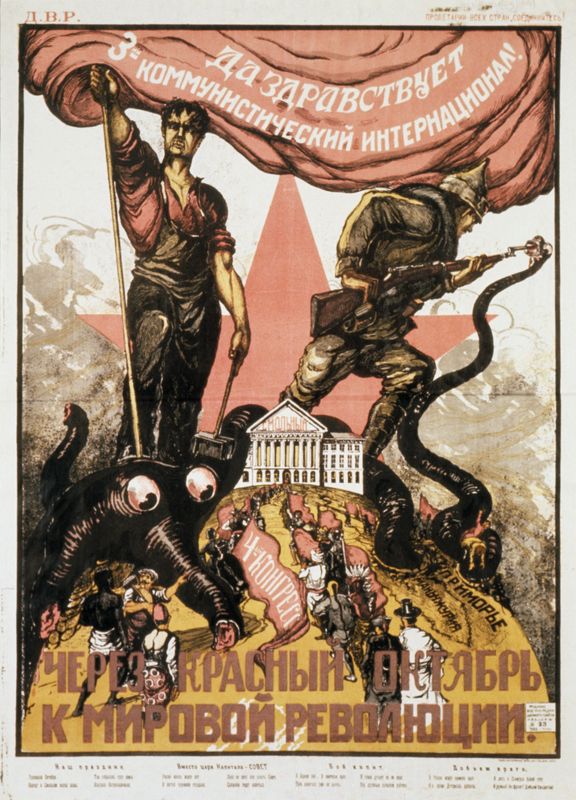
The following poster is titled: “Long Live the Third Communist International! From a Red October to a World Revolution” (Lavin, 2014). This poster represents a progressive attitude in communist propaganda during 1920. If looked at closely, one can find that the characters below the towering proletarian and soviet soldier are of mixed ethnicities and traversing a globe. The banner they carry reads “4th Congress”, alluding to the next revolutionary step in the spread of communism. Also, an octopus is located on the left side and is watching itself be dismembered. The octopus imagery is found in political propaganda and cartoons throughout much of the early 20th century. Usually, it is used as an allusion to represent a powerful evil that exercises control over vast amounts of territory, trapping whatever is within its grasp. The proletarians on the globe are represented as the heroes, skewing the beast and providing direction and safe passage for the rest of the world to the motherland. Some of the characters and countries have fallen prey to the monster, representing that people are falling victim to what can be assumed to be capitalism because the beast is residing on the most western side of the globe. Though it is common to see the communists portrayed as the heroes of the scene, it is worth noting that it also indirectly motions that everybody should blindly join communism. This proposed idea would mean rejecting the religions in which their cultures practice, among other issues in which the Bolsheviks do not condone or support. The idea that communism could be so easily transitioned into is also not surprising to come from the Soviet agenda.

The first poster to look at was released in 1930, which was made by Gustav Klutsis. The text on the poster translates to “with great labor, we will fulfill the plan” (Miller, 2017). The plan they are referencing is the first Five Year Plan, which was implemented by Stalin. This plan was to focus on the extreme growth of industry and agriculture within the Soviet Union. The usage of the imposed image of hands reaching up, with the faces of different Soviet citizens of all general backgrounds, shows that the goal of the “plan” could be achieved through every person in the Soviet Union. These types of posters were seen throughout this constructivist period but came to an abrupt end when World War Two began. The tone of the posters changed from focusing on industrial growth to protecting the “homeland” from impending fascism.
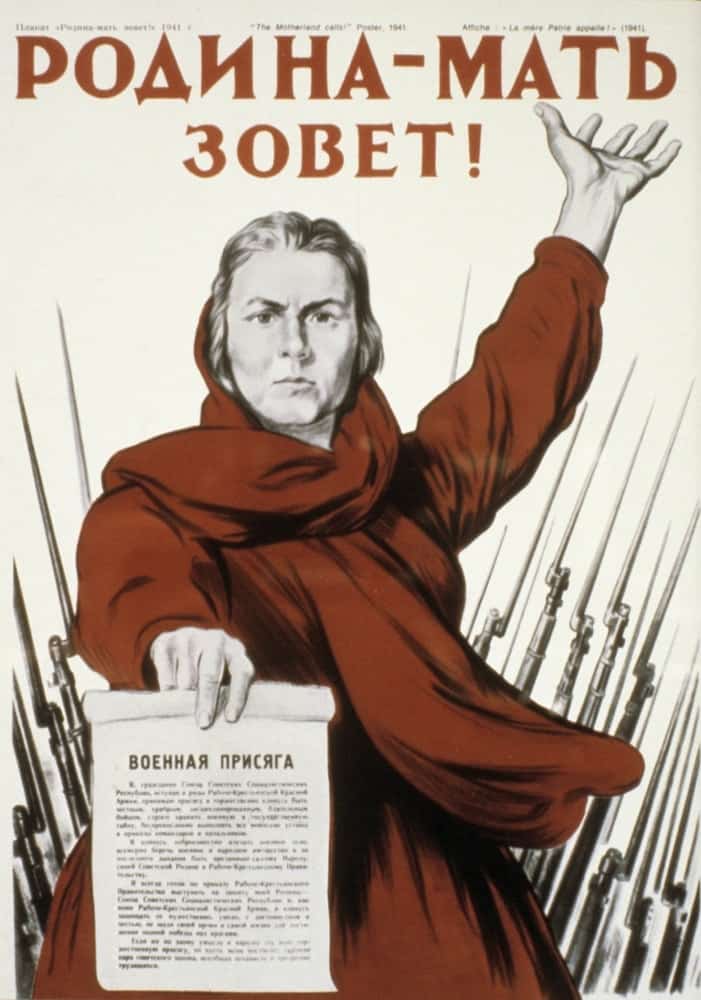
In the next poster, created during the beginning of World War Two, we see the major change mentioned previously. The text in this poster translates to “The Motherland Calls” (Miller, 2017). It is a simple few words that send an extremely powerful message – depicting the soviet Union as a mother, calling for protection from capable men. Her hand extended toward the sky, surrounded by bayonets and holding a call to join the military, this poster was to inspire deep patriotism. The Soviet Union was in need of thousands of soldiers to protect their extensive borders and propaganda served as a way for them to get as many people to join as possible. These posters could be seen throughout the Union up until the end of the World War – mixing between calls to action by the “motherland” and depicting Nazis creeping slowly on Soviet borders. After the war, though, there was the ushering in of the Cold War – ramping up the number of propaganda posters that focused on Soviet triumphs, rather than on calls to action.
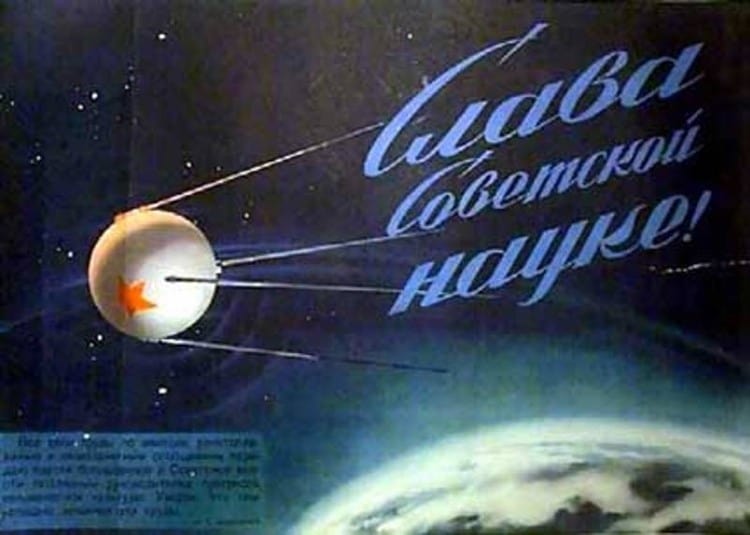
The last poster was created in 1957 and depicts one of the most famous pieces of Soviet space travel – Sputnik. The text on this poster translates to “Glory to Soviet Science!” (Miller, 2017). This was created after Sputnik successfully made it to space, making the Soviet Union the first country to ever put a satellite in space (Gerovitch, 2015). It was a great triumph for Soviet scientists, and that triumph was shared with the general public. This is one of the propaganda posters that focuses solely on the outcome of hard work, rather than on working together or on a war effort.
Bibliography:
Lavin, Talia. “35 Of The Most Impressive Communist Propaganda Posters.” HuffPost Canada. HuffPost Canada, December 26, 2014. Accessed 11, 2020. https://www.huffingtonpost.ca/entry/communist-propaganda-post_n_6377336.
Miller, Jacob. “50 Communist Propaganda Posters from the Soviet Union.” HistoryCollection.com, September 13, 2017. Accessed October 12, 2020. https://historycollection.com/50-communist-propaganda-posters-soviet-union/.
Slava Gerovitch. Soviet Space Mythologies : Public Images, Private Memories, and the Making of a Cultural Identity. Pitt Series in Russian and East European Studies. Pittsburgh, Pa: University of Pittsburgh Press, 2015. Accessed 11, 2020. http://search.ebscohost.com/login.aspx?direct=true&AuthType=shib&db=nlebk&AN=1006637&site=eds-live.
